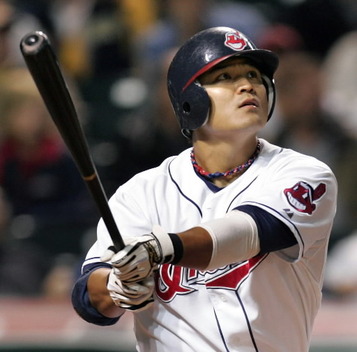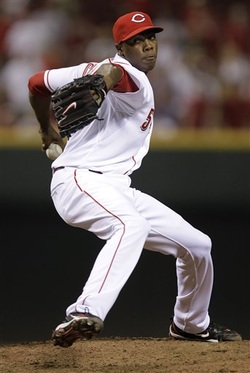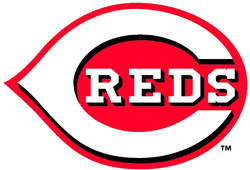There is a reason why Joey Votto collected just 56 runs batted in in 111 games in 2012. That reason is the guys hitting in front of him and not getting on base. The Reds had a league worst .254 OBP from their leadoff hitters in 2012. That problem was quickly solved in a deal that centered around outfielder Shin-Soo Choo. He was acquired, along with infielder Jason Donald and $3.5 million, from the Cleveland Indians in a trade that involved three teams and nine players overall. The Indians receive outfielder Drew Stubbs from Cincinnati and pitchers Trevor Bauer, Matt Albers and Bryan Shaw from the Diamondbacks. Arizona gets minor league shortstop Didi Gregorius, lefthander Tony Sipp and first baseman Lars Anderson from Cleveland .
With few weaknesses remaining on the major league club, the Reds have finally found their guy to bat leadoff. Shin Soo Choo has consistently shown the ability to get on base at a high level throughout his career with a .381 career OBP. After being injured in 2011, he came back strong in 2012 with a .283/.373/.441 batting line. Along with getting on base, Choo has good power and speed numbers as well with 43 doubles, 16 long balls, and 21 stolen bases in 2012. Additionally, he was a 20-home run, 20-stolen base guy in 2009 and 2010. The one hole in Choo’s overall offensive game is the strike out. He did that 150 times in 2012, which is not ideal from a leadoff hitter. However, Choo’s walk rate (10.6%) and ability to get on base is what the Reds are looking for when they traded for him. However, one major question Choo's acquisition presents is who will replace Stubbs in center? He was a below average right fielder in 2012, with -12 defensive runs saved and limited experience in center (83 innings). It has been documented that Choo will be the starting center fielder next season, but should continue to be a below average outfielder as he makes this positional transition. Also, the Reds got utility infielder Jason Donald from the Indians. Donald has never played more than 88 games in his 3 year career. Overall in 170 career games, Donald has hit .257/.309/.362 with 7 home runs. The Reds can use Donald to play multiple positions as he has played shortstop, second base, third base, and even 8 games in the outfield (5 in LF, 3 in CF) in 2012. Statistically however, it is shown that he is a below average defender with -12 defensive runs saved for his career.
Now, for the players the Indians received. Outfielder Drew Stubbs is a player who has flashed crazy tools, but has never compiled those numbers in a single season. Stubbs has shown to be a good speed threat with at least 30 stolen bases in his last 3 seasons. However, the trouble for him is getting on base. He has also struggled to hit for a consistent batting average with a career stat line of .241/.312/.386. Stubbs has not been able to walk much either, with just 44 in 544 plate appearances in 2012. A league-leading 205 strike outs in 2011, Stubbs' propensity to miss will not help his OBP as well. Throughout his career, he has just one defensive run saved and just two alone from last year, making him about an average defender in center. The Indians are hoping he can bounce back from a career worst -0.2 WAR in 2012 and add speed to their outfield and offensive game. Trevor Bauer may end up being the biggest piece of this trade, but he has yet to prove anything at the big league level. Bauer was drafted third overall in 2011, and was ranked as Arizona’s number one prospect in 2012. He has an extremely deep repertoire with a plus low-mid 90's fastball, elite 12-6 curveball, solid changeup, and his personally created "reverse slider" (as seen below for your viewing pleasure). Yet, he has shown little ability to throw strikes consistently, as evidenced by his below average 4.2 BB/9 rate in the minors.
With few weaknesses remaining on the major league club, the Reds have finally found their guy to bat leadoff. Shin Soo Choo has consistently shown the ability to get on base at a high level throughout his career with a .381 career OBP. After being injured in 2011, he came back strong in 2012 with a .283/.373/.441 batting line. Along with getting on base, Choo has good power and speed numbers as well with 43 doubles, 16 long balls, and 21 stolen bases in 2012. Additionally, he was a 20-home run, 20-stolen base guy in 2009 and 2010. The one hole in Choo’s overall offensive game is the strike out. He did that 150 times in 2012, which is not ideal from a leadoff hitter. However, Choo’s walk rate (10.6%) and ability to get on base is what the Reds are looking for when they traded for him. However, one major question Choo's acquisition presents is who will replace Stubbs in center? He was a below average right fielder in 2012, with -12 defensive runs saved and limited experience in center (83 innings). It has been documented that Choo will be the starting center fielder next season, but should continue to be a below average outfielder as he makes this positional transition. Also, the Reds got utility infielder Jason Donald from the Indians. Donald has never played more than 88 games in his 3 year career. Overall in 170 career games, Donald has hit .257/.309/.362 with 7 home runs. The Reds can use Donald to play multiple positions as he has played shortstop, second base, third base, and even 8 games in the outfield (5 in LF, 3 in CF) in 2012. Statistically however, it is shown that he is a below average defender with -12 defensive runs saved for his career.
Now, for the players the Indians received. Outfielder Drew Stubbs is a player who has flashed crazy tools, but has never compiled those numbers in a single season. Stubbs has shown to be a good speed threat with at least 30 stolen bases in his last 3 seasons. However, the trouble for him is getting on base. He has also struggled to hit for a consistent batting average with a career stat line of .241/.312/.386. Stubbs has not been able to walk much either, with just 44 in 544 plate appearances in 2012. A league-leading 205 strike outs in 2011, Stubbs' propensity to miss will not help his OBP as well. Throughout his career, he has just one defensive run saved and just two alone from last year, making him about an average defender in center. The Indians are hoping he can bounce back from a career worst -0.2 WAR in 2012 and add speed to their outfield and offensive game. Trevor Bauer may end up being the biggest piece of this trade, but he has yet to prove anything at the big league level. Bauer was drafted third overall in 2011, and was ranked as Arizona’s number one prospect in 2012. He has an extremely deep repertoire with a plus low-mid 90's fastball, elite 12-6 curveball, solid changeup, and his personally created "reverse slider" (as seen below for your viewing pleasure). Yet, he has shown little ability to throw strikes consistently, as evidenced by his below average 4.2 BB/9 rate in the minors.
Statistically speaking, Bauer struggled in 4 major league starts (6.06 ERA, 7.2 BB/9), but had very effective minor league numbers with AA and AAA. In 130.1 innings, he compiled a 2.42 ERA, 1.29 WHIP, and 157 strikeouts. Bauer will just be 22 years old in 2013 and the Indians are hoping he can live up to hype and be a productive starter for them in the future. The Indians will also receive bullpen help from Matt Albers and Bryan Shaw. Albers has struggled throughout his career with a career ERA of 4.68 and ERA+ of 94. However, still just 29 years old, Albers posted career-highs with the Red Sox and Diamondbacks in 2012. In 60.1 innings, he had a 2.39 ERA with a 181 ERA+. A hard thrower, Albers may have benefited from a lower walk rate in 2012. He walked walked 3.3 batters per 9 innings in 2012, compared to his career mark of 4.1 BB/9 and previous career high of 4.0 BB/9 in 2008 and 2010. Shaw, 24, is a young reliever with just 2 years of MLB experience. However he has shown he can be very productive in his 87.2 career innings pitched. He has an ERA of 3.18 and ERA+ of 129 for his career.
As for Arizona, they acquire shortstop Didi Gregorius, lefthander Tony Sipp and first basemen Lars Anderson in this deal. Gregorius, just 22 years old, has put up average numbers throughout his minor league career. He has batted .271/.323/.376 in 5 minor league seasons. Last year with AA and AAA he batted .265/.324/.393 with just 7 home runs and 3 stolen bases. He has the reputation of being a glove first, bat second, player capable of being a highlight film in the field. Lars Anderson, former Red Sox top prospect, has only played in 30 games in the big leagues and has hit .167/.268/.188. In the minor leagues he has hit .272/.369/.432 for his career with solid plate selection and a good glove. He has shown the ability to hit for power, although his home run total dropped to just 9 in 111 games in AAA. Lefty Tony Sipp has shown the ability to be productive, although very inconsistent during his four year stint in the majors. His ERA+’s from 2009-2012 have progressively worsened from 146 to 96 to 130 to 89. This inconsistency is a problem because of his wildness with a walk rate of 4.5 per nine innings.
First Impressions:
Winners: Reds, Indians: Reds added the leadoff they desperately needed, even if he might not be the best suited to play in center field. By dumping Choo, who had just one year remaining on his deal and would not have resigned with the Tribe, the Indians acquired an extremely talented arm in Bauer and decent outfield option in Stubbs with a combined 9 years of team control remaining.
Loser: Diamondbacks: Arizona acquired the young shortstop they so desperately coveted, except that Gregorious profiles most likely as a glove first shortstop. Nothing against defensive first shortstops who are young and have potential, but usually the price does not involve dealing a top pitching prospect, which is the downfall in this deal. If Gregorious can correct his offensive issues, this trade could work out for the D-Backs, but seems unlikely given his scouting and statistical profile.
By: Nick Rabasco
As for Arizona, they acquire shortstop Didi Gregorius, lefthander Tony Sipp and first basemen Lars Anderson in this deal. Gregorius, just 22 years old, has put up average numbers throughout his minor league career. He has batted .271/.323/.376 in 5 minor league seasons. Last year with AA and AAA he batted .265/.324/.393 with just 7 home runs and 3 stolen bases. He has the reputation of being a glove first, bat second, player capable of being a highlight film in the field. Lars Anderson, former Red Sox top prospect, has only played in 30 games in the big leagues and has hit .167/.268/.188. In the minor leagues he has hit .272/.369/.432 for his career with solid plate selection and a good glove. He has shown the ability to hit for power, although his home run total dropped to just 9 in 111 games in AAA. Lefty Tony Sipp has shown the ability to be productive, although very inconsistent during his four year stint in the majors. His ERA+’s from 2009-2012 have progressively worsened from 146 to 96 to 130 to 89. This inconsistency is a problem because of his wildness with a walk rate of 4.5 per nine innings.
First Impressions:
Winners: Reds, Indians: Reds added the leadoff they desperately needed, even if he might not be the best suited to play in center field. By dumping Choo, who had just one year remaining on his deal and would not have resigned with the Tribe, the Indians acquired an extremely talented arm in Bauer and decent outfield option in Stubbs with a combined 9 years of team control remaining.
Loser: Diamondbacks: Arizona acquired the young shortstop they so desperately coveted, except that Gregorious profiles most likely as a glove first shortstop. Nothing against defensive first shortstops who are young and have potential, but usually the price does not involve dealing a top pitching prospect, which is the downfall in this deal. If Gregorious can correct his offensive issues, this trade could work out for the D-Backs, but seems unlikely given his scouting and statistical profile.
By: Nick Rabasco




 RSS Feed
RSS Feed